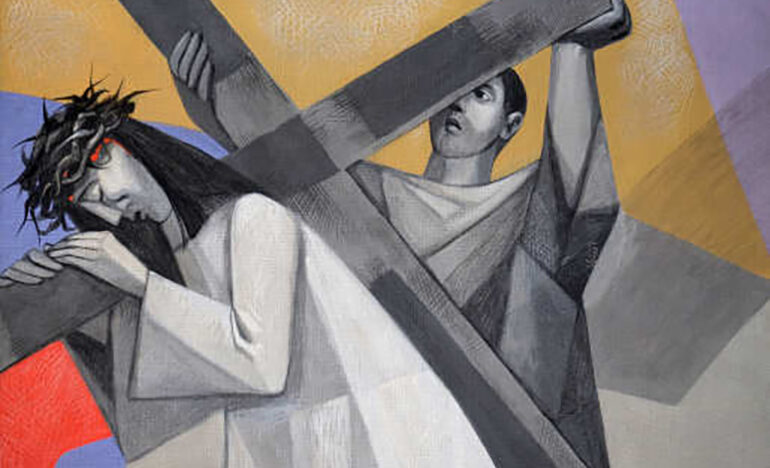Video Series: Prayer of Silence: Using an Image to Recenter

By Kathy Keary
Our full series in the Contemplative Prayer Video Series is here.
Our full series on Contemplation is here.
Today we will explore using an image to recenter ourselves when we become attached to a thought while engaged in the prayer of silence. I can’t emphasize enough that distractions in silent prayer are very normal. The interspiritual leader, Mirabai Starr, one of my favorite authors, amusingly describes the monkey mind in her book God of Love, A Guide to the Heart of Judaism, Christianity, and Islam. See if this sounds familiar.
You sit, you bow, you close your eyes, and then the circus begins. A thousand thoughts, dressed like clowns, come tumbling out of the tiny car of your mind and begin performing their tricks: I hope those shoes I saw at the mall are still on sale. I think she thinks I think I’m special, but I don’t. I think I’m a fraud. I could make burritos for dinner or just broil some fish. I wonder if it’s dangerous to eat fish, because of the mercury. My knee hurts. My knee still hurts. I may have torn a ligament in yoga class. It will take months to heal. This is a disaster.
Mirabai speaks truth about the human experience, but she encourages us to continue the pursuit of resting in silence with the God of Love. She writes:
Maybe when you carve out this sacred time to be still, to be quiet, you are doing all that needs to be done. Maybe, if you reflect on it, there really are moments of grace in between the moments of agitation, and if you were to string these together you would have a strand of contemplative jewels that make your life richer, deeper.
This resonates with my experience. Months after engaging in the prayer of silence, I realized that I had changed. I was more at peace, more loving, gentler, and more open to the Spirit’s influence in my life. So even though I am plagued by distractions, I sit down every day and avail myself to this sacred, life-giving practice.
We have talked about using our breath and using a sacred word to recenter ourselves when we realize that we are absorbed in a distraction. Visualizing an image is also a way to refocus our intention on the silence – on the stillness. The image I have used is that of the risen Christ. Allow the Spirit to guide your choice of images. It could be a Celtic knot, a peaceful scene, a spiral, or the Spirit. The options are endless. Pick an image that speaks to your heart.
Begin the prayer by visualizing the image that you have chosen as a statement of your intent to rest in God. When you realize that your mind has run away with a thought, briefly return to the image as a way to recenter.
Today we will explore the use of an image to recenter ourselves when we become attached to a thought while engaged in the prayer of silence. I can’t emphasize enough that distractions in silent prayer are very normal. The interspiritual leader Mirabai Starr, one of my favorite authors, amusingly describes these distractions, sometimes called “the monkey mind,” in her book God of Love, A Guide to the Heart of Judaism, Christianity, and Islam. See if this sounds familiar.
You sit, you bow, you close your eyes, and then the circus begins. A thousand thoughts, dressed like clowns, come tumbling out of the tiny car of your mind and begin performing their tricks: I hope those shoes I saw at the mall are still on sale. I think she thinks I think I’m special, but I don’t. I think I’m a fraud. I could make burritos for dinner or just broil some fish. I wonder if it’s dangerous to eat fish, because of the mercury. My knee hurts. My knee still hurts. I may have torn a ligament in yoga class. It will take months to heal. This is a disaster.
Mirabai speaks truth about the human experience, but she encourages us to continue the pursuit of resting in silence with the God of Love. She writes:
Maybe when you carve out this sacred time to be still, to be quiet, you are doing all that needs to be done. Maybe, if you reflect on it, there really are moments of grace in between the moments of agitation, and if you were to string these together you would have a strand of contemplative jewels that make your life richer, deeper.
This resonates with my experience. Months after engaging in the prayer of silence, I realized that I had changed. I was more at peace, more loving, gentler, and more open to the Spirit’s influence in my life. So even though I am plagued by distractions, I sit down every day and avail myself to this sacred, life-giving practice.
We have talked about using our breath and using a sacred word to recenter ourselves when we realize that we are absorbed in a distraction. Visualizing an image is also a way to refocus our intention on the silence – on the stillness. The image I have used is that of the risen Christ. Allow the Spirit to guide your choice of images. It could be a Celtic knot, a peaceful scene, a spiral, or the Spirit. The options are endless. Pick an image that speaks to your heart.
Begin the prayer by visualizing the image that you have chosen as a statement of your intent to rest in God. When you realize that your mind has run away with a thought, briefly return to the image as a way to recenter.
We use three minutes of silence in the videos for two reasons: First, so that the video is not too long, and second, it’s often advisable if you are new to this type of prayer that you begin with brief periods of silence. You may want to gradually increase that over time. I believe that any time spent in this type of prayer is fruitful.
I encourage you to journal about your experience today as you discern which method of recentering speaks most to you.
Next week we will focus on our stillness as a method to recenter ourselves.
Until then, may the God of Love hold you in the palm of his hand.
Note: Never miss an article published on the Renewal Center website: Sign up to receive our newsletters.
[Kathy Keary, spiritual director, holds a bachelor’s degree in education, a master’s degree in theological studies, and completed Sophia Center’s Souljourners Program, an intense study of spirituality and spiritual direction. Kathy believes that the Divine is present and active in all of life and encourages others to be awakened to the God in all including the Divine within. She enjoys accompanying others on their journey to wholeness discovering the person they were created to be.]
Photo 70125009 © Maksim Petrov | Dreamstime.com
We’d Like to Hear from You!
We’d like to know what you think about this article. Send us a comment using the form below. Do you have a suggestion? Is there something you want to learn more about? Send us a note.
Related

What’s the Problem?
By Fr. Garry Richmeier, C.PP.S.
You can’t fix a relationship or a behavior like a mechanic fixes a car or a surgeon “fixes” a patient. Behaviors and relationships don’t have parts that can be fixed or replaced when the break or malfunction.

Lent Video Five – Meditation: “Only a Shadow of You Love”
Next Sunday is Palm Sunday and next week is Holy Week. In anticipation of those solemn commemorations, today, Fr. Ron will help us pray and meditate on the Stations of the Cross.
Categories
Assembling God's Puzzle Coffee with Padre Cooking & Spirituality Encounters of the 4th Kind Family Matters Reflections on the Eucharsitic Prayers Spiritual Resources Taize Prayers The Contemplative Life Traveling with Pilgrims of Hope Uncategorized Videos Week of Prayer for Uhristian Unity When you need a little help
